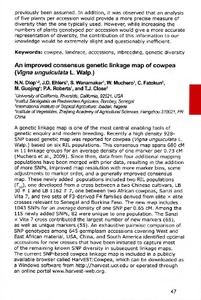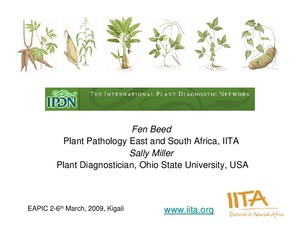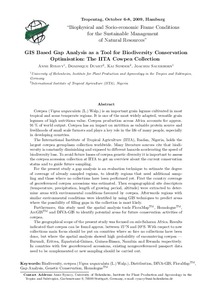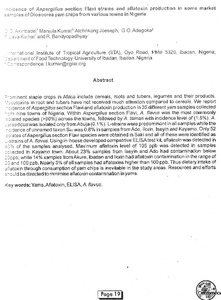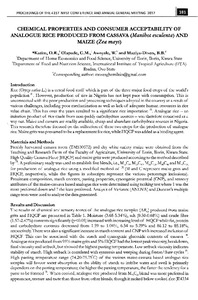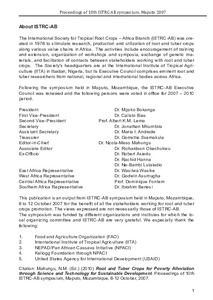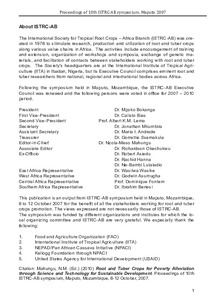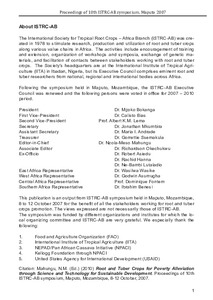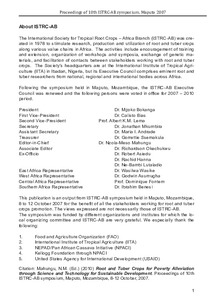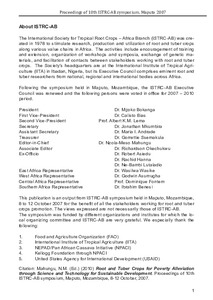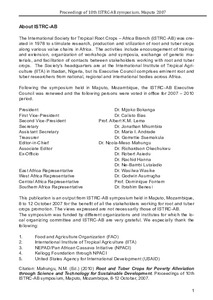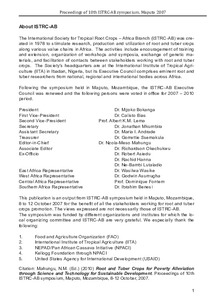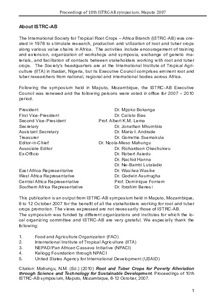Welcome to the International Institute of Tropical Agriculture Research Repository
Conference Documents: Recent submissions
Now showing items 661-680 of 726
-
Improving the productivity of cowpea in the savannas of northeast Nigeria through participatory evaluation and dissemination of improved varieties
(International Institute of Tropical Agriculture, 2012)Cowpea is a major food and cash crop in northern Nigeria, providing nutritious grain and a less expensive source of protein for both the rural poor and urban consumers. A number of improved varieties have been developed combining diverse plant type, and different maturity periods, with resistance or tolerance to several diseases, insect pests, and parasitic weeds and possessing other good agronomic traits. Despite this, farmers in northeast Nigeria have continued to grow predominantly local ... -
An improved consensus genetic linkage map of cowpea ( Vigna unguiculata L. Walp. )
(2012-10)Consensus genetic linkage maps are formed from merging individual linkage maps. They provide powerful tools for genetic analysis and a foundation for marker-assisted breeding, trait mapping, and positional cloning. In 2009, the first cowpea consensus map was developed. It included 928 markers spanning 11 linkage groups over a total map size of 680 centimorgans (cM), a 0.73 cM average marker distance. The map was the result of merging maps from 6 RIL populations genotyped with a 1536-SNP multiplexed ... -
Impact of climate change on the interdependency between countries in the use and exchange of microorganisms
(International Institute of Tropical Agriculture, 2009) -
International Plant Diagnostic Newtork (IPDN)
(International Institute of Tropical Agriculture, 2009) -
GIS based gap analysis as a tool for biodiversity conservation optimisation: the IITA cowpea collection
(2009-10)Cowpea (Vigna unguiculata(L.) Walp.) is an important grain legume cultivated in most tropical and some temperate regions. It is one of the most widely adapted, versatile grain legumes of high nutritious value. Cowpea production across Africa accounts for approx.91 % of world output. Cowpea has an impact on nutrition as valuable protein source and livelihoods of small scale farmers and plays a key role in the life of many people, especially in developing countries. The International Institute of ... -
Incidence of Aspergillus section Flavi strains and aflatoxin production in some market samples of Dioscorea yam chips from various towns in Nigeria
(International Institute of Tropical Agriculture, 2009) -
Weed management in Africa: experiences, challenges and opportunities
(British Crop Protection Council, 2007) -
Chemical properties and consumer acceptability of analogue rice produced from cassava (Manihot esculenta) and maize (Zea mays)
(Nigerian Institute of Food Science and Technology, 2017) -
Effect of nitrogen fertilizer and cassava variety on the sensory quality of composite bread
(International Institute of Tropical Agriculture, 2010)This paper reports how field application of nitrogen fertilizer and cassava variety affects the sensory quality of composite cassava-wheat bread. Fertilizer dosages of 0 and 160 kg/ha were applied during the raining season in a completely randomized trial plot located in Mokwa, in the Guinea savannah belt of Nigeria. The main effect of variety was significant on crust color and appearance (p<0.01) whereas fertilized application significantly influenced crumb structure and crust appearance (p<0.01). ... -
Sustainable approach for cassava processing in Africa
(International Institute of Tropical Agriculture, 2010)Cassava plays important roles. It is a famine reserve crop, a staple food for the rural populace and a cash crop for urban consumption. It is a source of industrial raw materials and earns foreign exchange. Unfortunately, the past decades witnessed too much emphasis on the production components of the research industry in Africa. Yesterday, traditional processing offered a low value, poor quality product and used poor storage methods with a low investment drive to restricted consumers. Today, a ... -
Iron bioavailability and utilization in rats fed cassava-based complementary diets
(International Institute of Tropical Agriculture, 2010)Iron deficiency anaemia is still a major nutritional problem in the world, affecting primarily infants, children, and fertile women in both developing and developed countries (UNICEF, 2006). Breast-fed infants generally have adequate iron status during the first 4-6 mo of life, after which stored iron is depleted. Additional dietary iron therefore needs to be supplied. Improved cassava–based diets can provide a large proportion of the daily intake of energy and micronutrients for poor populations ... -
Application of molecular marker-assisted selection in breeding for improved farmer/market preferred cassava varieties in Tanzania
(International Institute of Tropical Agriculture, 2010)Tanzania is the fifth largest producer of cassava in Africa, the eighth largest producer in the world with an estimated average yields of about 10.4 t/ha, which is far below the potential yield of the crop. The low yield is caused by a number of factors including susceptibility of commonly grown varieties to major diseases and pests including susceptibility of local varieties to major diseases and pests such as cassava mosaic diseases (CMD), caused principally by East African Cassava Mosaic Virus ... -
Introduction and evaluation of improved varieties of Dioscorea rotundata, and D. cayenensis with high micronutrient content in Cameroon
(International Institute of Tropical Agriculture, 2010)Yam (Dioscorea sp.) is an extremely important delicacy in Cameroon, with some estimated 45,215 hectares devoted to it, and corresponding annual production of 275,101 metric tons. Production is constrained by several factors including the limited availability and cost of planting material, as well as susceptibility to a range of pests and diseases that cause considerable pre- and post- harvest losses, translated into low yields and poor quality of tubers during storage. With the development of new ... -
Evaluation of the performance of five hybrid water yam clones in the yam belt of Nigeria
(International Institute of Tropical Agriculture, 2010)The performance of 5 promising pre-release hybrid water yam (D. alata) varieties (TDa 98/01166; TDa 98/01176; TDa 98/01168; TDa 99/91169; and TDa 99/00240) evaluated for high and stable yields, pest and disease resistance and desirable food qualities, was determined in 2004 and 2005 in 6 locations in the Nigerian yam belt. The trials were laid out in randomized complete block design in three replications in each location. The results from two year fresh tuber yield and disease severity scores show ... -
Feeding and economic value of cassava starch by-products to growing fattening pigs
(International Institute of Tropical Agriculture, 2010)An experiment was conducted to evaluate the feeding and economic value of cassava starch by-products as source of energy in diets for growing fattening pigs. Cassava starch by-products were incorporated in the diets at 0 (treatment 1, control), 10 (treatment 2), 20 (treatment 3) and 30% (treatment 4). Each treatment had three replicates arranged as unbalanced incomplete block design. Pigs fed treatment 4 had the highest (p<0.05) feed intake (23.05), body weight gain (62.90) and growth efficiency ... -
Towards improving the nutritional quality of cassava: progress in the genetic enhancement of carotenoids, iron, zinc, and protein levels
(International Institute of Tropical Agriculture, 2010)Though cassava (Manihot esculenta Crantz) is a staple for many poor people in Africa, it has major nutritional disadvantages. The tuberous root has very low levels of essential nutrients. Consequently, malnutrition is widespread among the people who depend on as a staple in their diet. Breeding cassava for enhanced nutritional quality and making such biofortified varieties available to endusers could help prevent related deficiencies. This paper presents experiences and progress in the genetic ... -
The incidence of the cassava mosaic disease in relation with the source of planting materials and its impact on cassava production
(International Institute of Tropical Agriculture, 2010)An experiment was conducted over two years (in 2004 and 2005) at the research station of the National Institute of Agricultural Study and Research (INERA) in Mvuazi, Bas-Congo province to determine the incidence of the cassava mosaic disease (CMD) in relation to the source of planting material and its impact on cassava yield. In the first year, two treatments were assessed, (1) healthy cuttings obtained from plots managed with phytosanitation through rouging and, (2) cuttings collected at random ... -
Effect of cassava leaf harvesting on root yield and quality
(International Institute of Tropical Agriculture, 2010)Cassava leaves are increasingly becoming an important source of nutrition for both human beings and livestock. A study was conducted at Chitedze Research Station, Malawi, to determine the effects of leaf harvesting on root yield and quality from 2003/04 to 2005/06 season. Two cassava varieties were used which included Mbundumali, a sweet variety with low potential for cyanogenic glucosides and widely grown by farmers; and Silira (TMS 60142B) an improved variety which is bitter, originated from ... -
Linking farmers to markets: opportunities and challenges for cassava farmers in Malawi
(International Institute of Tropical Agriculture, 2010)In an effort to improve rural farmer’s livelihood, many initiatives have been initiated in Sub-Saharan Africa (SSA) to link cassava farmers to markets. Several models have been used including use of leading entrepreneurs, targeting farmers’ associations/groups, conducting industrial tests to sensitize and create new markets, use of out-growers scheme and use of farmer-to –trader linkages. These models have been applied for a range of value chains in the cassava industry including starch, high ...


